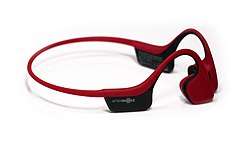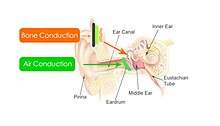Bone conduction
Bone conduction is the conduction of sound to the inner ear primarily through the bones of the skull, allowing the hearer to perceive audio content without blocking the ear canal. Bone conduction transmission occurs constantly as sound waves vibrate bone, specifically the bones in the skull, although it is hard for the average individual to distinguish sound being conveyed through the bone as opposed to sound being conveyed through air via the ear canal. Intentional transmission of sound through bone can be used with individuals with normal hearing - as with bone-conduction headphones - or as a treatment option for certain types of hearing impairment. Bone generally conveys lower-frequency sounds better than higher frequency sound.

Overview

Bone conduction is one reason why a person's voice sounds different to them when it is recorded and played back. Because the skull conducts lower frequencies better than air, people perceive their own voices to be lower and fuller than others do, and a recording of one's own voice frequently sounds higher than one expects.[1][2]
Musicians may use bone conduction using a tuning fork while tuning stringed instruments. After the fork starts vibrating, placing it in the mouth with the stem between the back teeth ensures that one continues to hear the note via bone conduction, and both hands are free to do the tuning.[3] Ludwig van Beethoven used bone conduction after losing most of his hearing, by placing one end of a rod in his mouth and resting the other end on the rim of his piano.[4]
It has also been observed that some animals can perceive sound and even communicate by sending and receiving vibration through bone.[5]
Comparison of hearing sensitivity through bone conduction and directly through the ear canal can aid audiologists in identifying pathologies of the middle ear—the area between the tympanic membrane (ear drum) and the cochlea (inner ear). If hearing is markedly better through bone conduction than through the ear canal (air-bone gap),[6] problems with the ear canal (e.g. ear wax accumulation), the tympanic membrane or ossicles can be suspected.[7]
Hearing aids
Some hearing aids employ bone conduction, achieving an effect equivalent to hearing directly by means of the ears. A headset is ergonomically positioned on the temple and cheek and the electromechanical transducer, which converts electric signals into mechanical vibrations, sends sound to the internal ear through the cranial bones. Likewise, a microphone can be used to record spoken sounds via bone conduction. The first description, in 1923, of a bone conduction hearing aid was Hugo Gernsback's "Osophone",[8] which he later elaborated on with his "Phonosone".[9]
After the discovery of Osseointegration around 1950 and its application to dentistry around 1965, it was noticed that implanted teeth conducted vibrations to the ear. As a result, bone anchored hearing aids were developed and implanted from 1977 on.
Products
Bone conduction products are usually categorized into three groups:
- Ordinary products, such as hands-free headsets or headphones
- Bone-anchored hearing aids and assistive listening devices
- Specialized communication products (e.g. for underwater or high-noise environments)
One example of a specialized communication product is a bone conduction speaker that is used by scuba divers. The device is a rubber over-moulded, piezoelectric flexing disc that is approximately 40 millimetres (1.6 in) across and 6 millimetres (0.24 in) thick. A connecting cable is moulded into the disc, resulting in a tough, waterproof assembly. In use, the speaker is strapped against one of the dome-shaped bone protrusions behind the ear and the sound, which can be surprisingly clear and crisp, seems to come from inside the user's head.[10]
Safety
Because bone conduction headphones transmit sound to the inner ear through the bones of the skull, users can consume audio content while maintaining situational awareness.
Use in the 21st century
The Google Glass device employs bone conduction technology for the relay of information to the user through a transducer that sits beside the user's ear. The use of bone conduction means that any vocal content that is received by the Glass user is nearly inaudible to outsiders.[11]
German broadcaster Sky Deutschland and advertising agency BBDO Germany collaborated on an advertising campaign that uses bone conduction that was premiered in Cannes, France at the International Festival of Creativity in June 2013. The "Talking Window" advertising concept uses bone conduction to transmit advertising to public transport passengers who lean their heads against train glass windows. Academics from Australia's Macquarie University suggested that, apart from not touching the window, passengers would need to use a dampening device that is made of material that would not transmit the vibration from the window in order to not hear the sound.[12][13]
Land Rover BAR employed 'military' bone conduction technology, designed by BAE Systems, within their helmets for use within the 2017 America's Cup.[14] The helmets allowed the crews to communicate effectively with each other under race conditions and within the harsh, noisy environment; whilst maintaining situational awareness due to their ears being uncovered.[15]
In March 2019 at The National Maritime Museum, London, British composer Hollie Harding premiered the use of Bone Conduction Headphones as part of a musical performance.[16] The use of the technology allowed the audience to listen to a pre-recorded musical track on the headsets, whilst a live orchestra performed a separate, but related, musical track. This multilayered effect meant that electronic and digitally-edited sounds could be heard in conjunction with live music without the use of loud-speakers for the first time, and that the source of sounds could appear to be close to, far from, or all around the listener.
Bone conduction technology has found many other uses in the corporate world, in particular with technology companies trying to cultivate a collaborative team environment. Bone conduction technology allows computer programmers and dev teams to work in a team-focused environment with the ability to communicate and collaborate while maintaining the ability to listen to music, audio books or join teleconference calls.[17]
See also
- Bone conduction auditory brainstem response
- Weber test
- Rinne test
- Headphones
- Cochlear Baha
- SoundBite Hearing System
References
- Zhi Cai; Alan G. Madsen; Douglas G. Richards; Martin L. Lenhardt (2002). "Response of Human Skull to Bone Conducted Sound in the Audiometric to Ultrasonic Range" (PDF). Response of Human Skull to Bone Conducted Sound in the Audiometric to Ultrasonic Range. Virginia Commonwealth University. Retrieved 3 July 2013.
- Brent Zupp (2003–2012). "Why Does Your Voice Sound Different on a Recording?". Wanderings. Brent Zupp. Retrieved 3 July 2013.
- Dan Fox (1996). Teach Yourself to Play Mandolin. Alfred Music Publishing. ISBN 9780739002865. Retrieved 3 July 2015.
- Liam did this. "Bone Conduction: How it Works". www.goldendance.co.jp. Retrieved 2018-11-13.
- "Elephants pick up good vibrations -- through their feet: 3/01". news.stanford.edu. Retrieved 2019-06-29.
- Maltby, Maryanne Tate. (2012). A supplementary dictionary of audiology (1st ed.). [Oxford]: Oxford University Press. ISBN 9780199651467. OCLC 822262757.
- "Conductive Hearing Loss". American Speech-Language-Hearing Association. Retrieved 2019-06-29.
- US 1521287, Gernsback, Hugo, "Acoustic Apparatus", published 19 May 1923, issued 30 December 1924
- Kennedy, T. R., Jr. (1958). "From Coherer to Spacistor" (PDF). Radio-Electronics. Gernsback Publications. 29 (4): 45–59.
- Banks, Lindsey. "The History of Bone Conduction". gettysburg.edu. Retrieved 11 July 2015.
- Charles Arthur (2 July 2013). "Google Glass – hands-on review". The Guardian. Retrieved 3 July 2013.
- Catherine McMahon; Phillip Nakad (12 July 2013). "Bone conduction: the new front in guerilla advertising". The Conversation Australia. Retrieved 15 July 2013.
- Leo Kelion (3 July 2013). "Talking train window adverts tested by Sky Deutschland". BBC News. Retrieved 15 July 2013.
- Racing, Ben Ainslie. "The challenge of onboard communication - Land Rover Ben Ainslie Racing". land-rover-bar.americascup.com. Archived from the original on 2017-09-05. Retrieved 2018-01-12.
- "Our bone conduction technology is set to raise the bar in Bermuda | BAE Systems | International". BAE Systems | International. Retrieved 2018-01-12.
- "Concert: Melting, Shifting, Liquid World". Royal Museums Greenwich | UNESCO World Heritage Site In London. 2019-01-29. Retrieved 2019-03-21.
- Passante, Jason (Feb 4, 2018). "Bone Conduction Through History". Audio Reputation.